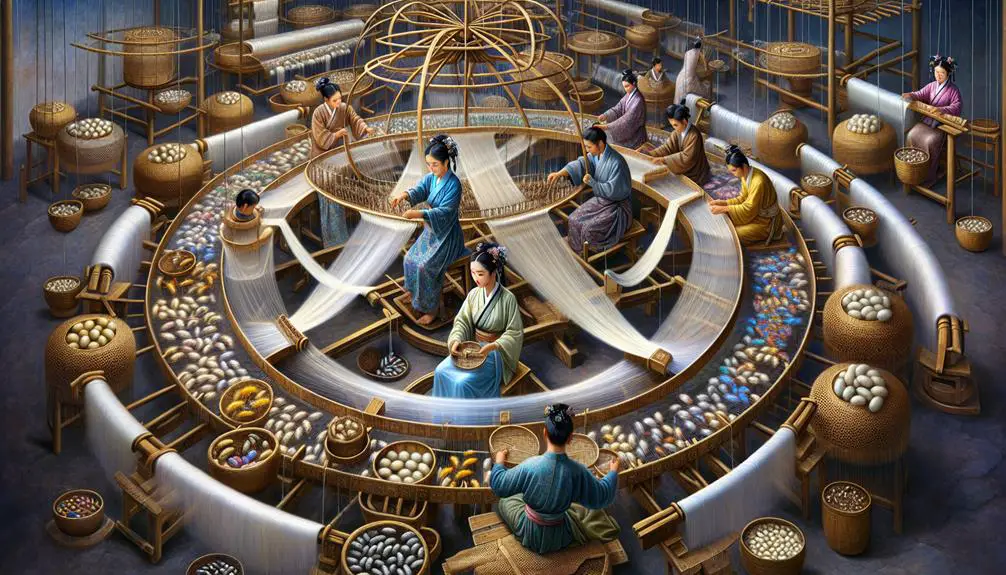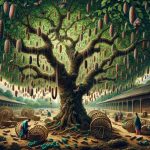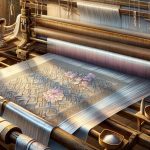Silk was invented to adorn the elite with luxury and prestige, thanks to Empress Leizu's accidental discovery in ancient China. Its creation led to the silk reel and loom development, becoming a symbol of wealth. Initially a status symbol, silk expanded beyond clothing into banners and art, embodying opulence. The silk trade routes transformed commerce and cultural connections, shaping civilizations. Over time, silk processing techniques evolved, enhancing production efficiency. Silk farming spread globally, promoting cultural exchange. Discover more about the evolution and impact of silk on ancient societies.
Table of Contents
Key Takeaways
- Empress Leizu accidentally discovered silk around 2700 BC.
- Silk invention led to the development of silk reel and loom.
- Silk became a symbol of wealth and prestige.
- Initially, silk was a luxurious status symbol for the elite.
- Silk trade routes expanded commerce and cultural exchange.
Origins of Silk Invention
Silk's invention in ancient China around 2700 BC by Empress Leizu marks a significant milestone in human history, revolutionizing various aspects of society. Initially, silk was a luxurious status symbol, highly sought after for its exquisite feel and appearance. Empress Leizu's invention of silk as a fabric for clothing elevated its status, making it a symbol of wealth and sophistication.
The origins of silk as an invention in China can be traced back to the accidental discovery by Empress Leizu herself. Legend has it that a silkworm cocoon fell into her cup of tea, unraveling the delicate threads that would become known as silk. This discovery led to the development of the silk reel and silk loom, essential tools for processing silk efficiently.
As silk production spread throughout China, it became not only a symbol of status but also a versatile material used for clothing, currency, and even paper. The invention of silk by Empress Leizu laid the foundation for a thriving silk industry that would shape Chinese culture and economy for centuries to come.
Empress Leizus Discovery
Stumbling upon a silkworm cocoon in my cup of tea, Empress Leizu's accidental discovery paved the way for the revolutionary invention of silk. This serendipitous moment in ancient China sparked a transformation in the textile industry, leading to the establishment of sericulture. As I marveled at the delicate fibers extracted from the cocoon, I realized the immense potential of this luxurious material.
Empress Leizu's keen insight and ingenuity propelled her to create the silk reel and loom, essential tools for processing silk. This marked the beginning of silk production as a sophisticated craft, elevating its status from a mere fabric to a coveted symbol of wealth and prestige. The allure of silk transcended its practical uses, evolving into a symbol of sophistication and refinement.
Her discovery not only enriched ancient Chinese culture but also laid the foundation for a thriving silk industry that would shape economies and trade for centuries to come. Empress Leizu's accidental encounter with the silkworm cocoon forever altered the course of history, establishing silk as a treasured commodity with roots deeply embedded in ancient Chinese heritage.
Silks Early Uses
In ancient times, silk served a multitude of purposes beyond clothing, showcasing its versatility and significance in various aspects of society. Initially invented for its smooth texture and natural sheen, silk quickly became a luxury fabric reserved for the elite in ancient cultures. It wasn't only a symbol of wealth and status but also a prominent trade commodity along the Silk Road.
The elite used silk for various applications such as banners, furnishings, and ceremonial items, highlighting its versatility. Silk embroidery emerged as a refined art form, demonstrating the intricate craftsmanship that could be achieved with this delicate material. The early uses of silk extended far beyond mere clothing, encompassing a wide range of practical and artistic endeavors that solidified its position as a symbol of luxury and refinement in ancient societies.
Symbolism and Status of Silk
Silk has always been more than just a fabric; it embodies wealth, luxury, and prestige.
In ancient China, silk was a symbol of social status, reserved for the elite.
The cultural significance of silk as a luxurious symbol is deeply ingrained in history.
Silk as Luxurious Symbol
As a symbol of wealth and status, the shimmering allure of silk captivated ancient societies, establishing it as a coveted fabric among the elite. Silk's exclusive nature and luxurious sheen made it a prized possession that signified sophistication and elevated social class.
Wearing silk garments was a clear indicator of one's elevated status and refined taste, setting apart the wealthy and powerful from the rest. The rarity and beauty of silk also made it a form of currency in ancient times, further emphasizing its importance and desirability.
- Silk's shimmering appearance made it highly sought after.
- Silk symbolized social class and sophistication.
- Wearing silk garments indicated elevated status.
- Silk was used as a form of currency.
- Silk was a prized possession due to its rarity and beauty.
Silk Signifies Prestige
The allure of silk's shimmering threads not only mesmerized ancient societies but also served as a tangible emblem of wealth and distinction. Silk held a prominent place in high society, restricted to the imperial family and elite circles in China, where it symbolized prestige and wealth. This luxurious fabric even transcended its material value, becoming a form of currency that highlighted the elevated status of its possessors. Wearing brightly colored silk robes was a visual declaration of social standing and power in ancient civilizations. In addition, laws in some societies prohibited the lower classes from adorning silk garments, solidifying its association with nobility and authority. Over time, silk embroidery transformed into a refined art form, adding to the luxurious and prestigious image of silk.
| Keywords | Description |
|---|---|
| Silk | Luxurious fabric |
| Prestige | Symbol of distinction |
| Wealth | Sign of prosperity |
| High Society | Reserved for elites |
| Art Form | Evolved into refined embroidery |
Cultural Importance of Silk
Amidst the intricate tapestry of ancient cultures, silk emerged as a symbol of opulence and distinction, weaving its way into the very fabric of societal hierarchy and status. Silk held immense cultural importance, representing wealth and social status, as evident in its exclusivity to the imperial family and elite in China.
Its value was so profound that it evolved into a form of currency within ancient Chinese society, underscoring its pivotal role in economic transactions. Moreover, silk served as a principal diplomatic gift from the Chinese emperor to neighboring nations for centuries, emphasizing its significance in fostering international relations.
The versatility of silk extended beyond attire, finding applications in writing and various cultural practices, solidifying its status as a symbol of prestige and social class.
Silk Trade on the Silk Route
The Silk Route was an essential network connecting East and West, facilitating the exchange of goods, ideas, and cultures.
Silk played a central role in expanding trade routes, influencing the development of civilizations along the way.
As silk traveled along these routes, it not only brought wealth but also fostered a rich cultural exchange that shaped the world as it is today.
Silk Route Importance
Traversing the ancient Silk Route was a journey filled with excitement and opportunity for traders seeking to exchange goods and ideas between East Asia and distant lands. Along this legendary trade route:
- Silk Trade: Silk, a highly valued commodity, was traded for items like gold, silver, horses, and jewels.
- Chinese Monopoly: China monopolized silk production for centuries, utilizing Mulberry silkworms to create high-quality silk.
- Byzantine Influence: Byzantine monks smuggled silkworm eggs, kickstarting silk production outside China.
- Spread of Silk: Silk production expanded to regions like Persia, Europe, Andalusia, and Venice.
- Prominent Centers: Andalusia in Spain and Venice in Italy became notable silk-making hubs, showcasing the Silk Road's impact on global trade.
Trade Routes Expansion
Expanding beyond the Silk Route's origins, the trade routes saw a flourishing exchange of silk that propelled economic growth and cultural interactions across diverse civilizations. China's monopoly on silk production drove the spread of silk-making techniques along the silk trade routes. Byzantine monks clandestinely transported silkworm eggs, enabling the establishment of silk production in Byzantium. This exchange of silk not only facilitated economic growth but also promoted cultural exchange, as silk became a sought-after commodity in various civilizations. The intricate trade networks established through the silk trade routes not only boosted economies but also fostered connections between distant lands, enriching societies with new ideas and technologies.
| Keywords | Description |
|---|---|
| Silk trade routes | Expanded exchange routes for silk trading |
| China's monopoly | Controlled silk production for millennia |
| Byzantine monks | Smuggled silkworm eggs to spread silk production |
| Economic growth | Enhanced economies through silk trade |
Cultural Exchange Influence
Journeying along the Silk Road introduced me to a vibrant tapestry of cultures interwoven through the exchange of silk and ideas. The Silk trade facilitated cultural exchange between China, Egypt, Persia, Greece, and Rome.
The Silk Route, established around 200 AD, connected China to the Mediterranean Sea, promoting the spread of silk production techniques. China's silk monopoly led to the smuggling of silkworm eggs to Byzantium by Byzantine monks, sparking silk-making in the region.
Silk production spread to Persia and later Europe, with regions like Andalusia in Spain and Venice in Italy becoming prominent silk-making centers. The Silk Road played a significant role in the exchange of goods and ideas among ancient civilizations, with silk being a highly valued commodity.
Evolution of Silk Processing Techniques
Silk processing techniques have undergone significant advancements throughout history, revolutionizing the production of this luxurious fabric. The evolution of silk processing techniques has been marked by innovations such as the degumming process, which effectively removes sericin from silk threads, enhancing their quality. Over time, sericulture techniques have been refined, leading to increased silk production efficiency and better overall quality of the fabric. Advanced throwing methods have also been developed to efficiently combine silk threads into yarn, facilitating the weaving process.
Incorporating both modern technologies and traditional methods, silk processing techniques have reached new heights in ensuring the production of high-quality silk. These advancements haven't only streamlined the production process but also maintained the integrity and craftsmanship associated with silk manufacturing. By embracing a combination of innovation and tradition, the industry continues to meet the demands for exquisite silk fabrics while upholding its historical significance and cultural value.
Impact on Ancient Civilizations
Silk's impact on ancient civilizations was profound.
The creation of trade routes solely dedicated to silk revolutionized commerce, while the development of advanced textile production methods elevated societies' craftsmanship.
Additionally, the cultural significance of silk transcended borders, influencing fashion, social hierarchies, and symbolizing power and sophistication.
Silk Trade Routes
The ancient trade routes of antiquity wove together distant civilizations through the exchange of valuable commodities like silk, fostering cultural connections and economic prosperity. As silk traveled along the Silk Road, it not only served as a luxurious fabric but also facilitated cultural exchange and economic growth among ancient civilizations.
Some key points to ponder about the impact of silk trade routes are:
- Byzantine monks played a pivotal role by smuggling silkworm eggs from China.
- Silk was exchanged for goods like gold, silver, horses, and jewels along the Silk Route.
- Silk production spread to regions like Persia and Europe after the introduction of silkworms from China.
- China held a monopoly on silk production, outputting 150,000 metric tons annually.
- The Silk Road fostered diverse cultural connections and economic prosperity for many civilizations.
Textile Production Methods
Ancient civilizations developed intricate textile production methods that revolutionized their economies and cultural landscapes. Silk production, with its techniques like sericulture and advanced weaving methods, became a cornerstone of ancient textile manufacturing. The table below highlights the impact of silk production on these civilizations:
| Impact of Silk Production | Description |
|---|---|
| Economic Growth | Silk became a valuable trade commodity, boosting economies. |
| Technological Advancements | Introduction of silk weaving looms improved production efficiency. |
| Cultural Exchange | Silk trade routes like the Silk Road facilitated cultural exchange. |
The refinement of silk production methods elevated the status of civilizations engaged in this industry, shaping their economic prosperity and fostering cultural interconnectivity through trade routes like the Silk Road.
Cultural Significance of Silk
Cultivating an air of opulence and distinction, silk epitomized status and luxury in the annals of historical civilizations. Its impact on ancient societies was profound, shaping cultural norms and influencing diplomatic relations.
Through the trade of silk along the renowned Silk Road, civilizations like China, Persia, and Rome thrived economically, showcasing the significance of this luxurious fabric. Silk not only symbolized wealth but also served as a status symbol, reserved for the elite classes. Its exclusivity was enforced through laws and social customs, highlighting its prestige.
Additionally, silk's versatility extended beyond clothing, finding its way into various aspects of art, writing, and religious ceremonies, further solidifying its cultural importance.
Spread of Silk Farming
Having spread from China to various civilizations, silk farming revolutionized textile production across the world. The dissemination of silk farming techniques from China to countries like Korea, Japan, India, Byzantium, Arabia, the Levant, and Italy played a crucial role in the global expansion of silk production. Chinese silk production, which was initially a state-controlled industry, influenced the silk farming practices in Korea and Japan. This transmission of knowledge led to the development of unique silk patterns and designs in regions like Byzantium and Persia after acquiring silkworm eggs from China. Japan, in particular, became a significant silk producer after adopting silk farming techniques in the 4th century AD.
| Civilization | Contributions |
|---|---|
| China | Origin of silk farming techniques |
| Korea & Japan | State-controlled silk production |
| Byzantium & Persia | Development of unique patterns |
| Japan | Significant silk producer |
| Arabia & Levant | Adoption of silk farming techniques |
Silks Role in Cultural Exchange
Silk, as a conduit for cultural exchange, transcended borders and connected distant civilizations along the Silk Road. The exchange of this luxurious fabric went beyond mere transactions; it became a symbol of wealth and status, shaping the very fabric of ancient civilizations.
- Silk Road: Acted as an essential network linking East Asia to Europe, India, and Africa, fostering trade and intellectual exchange.
- Luxury Commodity: Silk was more than just a fabric; it symbolized opulence and prestige, influencing social hierarchies.
- Wealth and Status: Owning silk garments signified affluence and high social standing in various cultures along the Silk Road.
- Silk Farming Techniques: The Silk Route spurred the development of silk production methods in regions like Persia, Byzantium, and Italy.
- Impact on Ancient Civilizations: Silk trade not only enriched economies but also facilitated cultural diffusion, shaping societies along its path.
Silk as a Luxury Commodity
I marveled at the allure of silk, a fabric that epitomized luxury and sophistication in ancient societies. Silk wasn't merely a material; it was a status symbol, a marker of high value and exclusivity. In ancient China, silk quickly became synonymous with prestige, reserved for the imperial family and the elite. Its shimmering appearance and soft texture made it highly coveted, elevating its reputation as a luxury commodity.
The vital process of silk production played a key role in enhancing its luxurious aura. The meticulous care and effort required to cultivate silk worms, harvest the delicate threads, and weave the fabric added to its exclusiveness. Silk's exceptional properties, including its strength, sheen, and elegant drape, further solidified its position as a prized fabric for the privileged few.
As a symbol of wealth and sophistication, silk found its way into various prestigious applications, from royal garments to luxurious furnishings, reinforcing its reputation as a fabric fit for the elite.
Technological Advancements in Silk Production
With the advent of technological advancements in silk production, the industry saw a significant transformation in efficiency and quality. The introduction of tools like the silk reel and silk loom revolutionized the way silk was manufactured, making the process more streamlined and effective.
This led to the mass production of silk fabrics, meeting the increasing demand for this luxurious material. Innovations in advanced weaving techniques not only improved the overall quality of silk products but also expanded the design possibilities, allowing for intricate patterns and textures to be created with ease.
The continuous technological progress in silk production played an important role in propelling the popularity of silk worldwide, making it more accessible to a broader audience and solidifying its status as a sought-after luxury commodity.
Legacy of Silk in Modern Times
A lasting emblem of sophistication and refinement, silk maintains its allure in the contemporary world of fashion and interior design. The silk industry plays a vital role in supporting millions of people globally, offering sustainable livelihoods and contributing to local economies. Modern advancements in production techniques have enhanced efficiency without compromising the premium quality that silk is known for. This luxurious fabric continues to be highly sought after for its durability, soft texture, and natural sheen, making it a staple in high-end fashion and home decor.
| Luxury | Elegance | Versatility | Sustainable Livelihoods |
|---|---|---|---|
| Silk is synonymous with luxury and is often associated with high-end products. | The elegance of silk fabric adds a touch of sophistication to any garment or decor item. | Silk's versatility allows it to be used in a wide range of products, from clothing to bedding. | The silk industry provides sustainable livelihoods for millions of people worldwide. |
Frequently Asked Questions
What Was the Purpose of Silk?
The purpose of silk was multifaceted. It served as a luxurious fabric for clothing, writing material, banners, and more. Brightly colored silk robes denoted social status. Silk's shimmering appearance and rarity made it a symbol of wealth and craftsmanship.
What Are the Reasons for Silk?
Silk, prized for its luxurious feel, sheen, and durability, was invented for its unique properties that made it highly desirable for trade and cultural exchanges. It played a vital role in shaping early economies and global commerce.
What Is the Invention Story of Silk?
Discovering silk by accident, Empress Leizu found a cocoon in her tea, leading to its invention around 2700 BC in China. Archeological evidence supports this origin, and the silk reel and loom furthered production.
How Was Silk Accidentally Created?
Accidentally created in ancient China, silk originated when a silkworm cocoon fell into Empress Leizu's tea, leading to the discovery of silk filament. This chance event revolutionized textile production, sparking a global trade in this luxurious fabric.
- Tetron Fabric for Marine Applications: Durability and Use Cases - June 18, 2025
- Tetron Fabric for Outdoor Furniture: Weather Resistance and Care - June 18, 2025
- Tetron Fabric for Wall Coverings: Style and Application Tips - June 18, 2025







